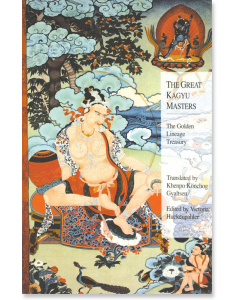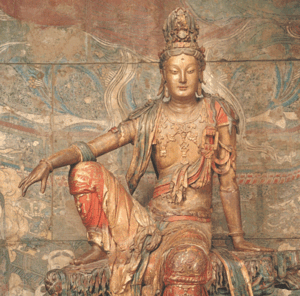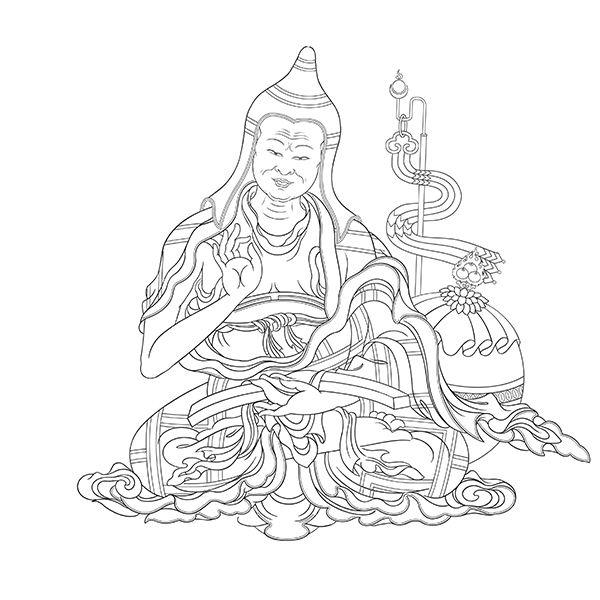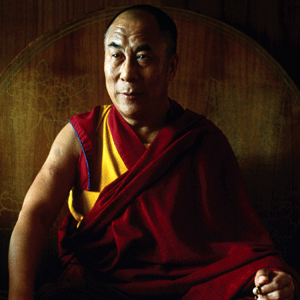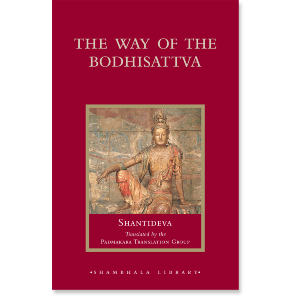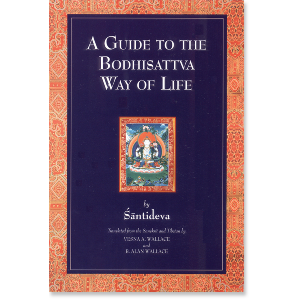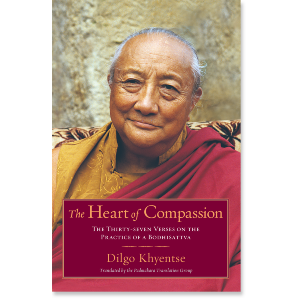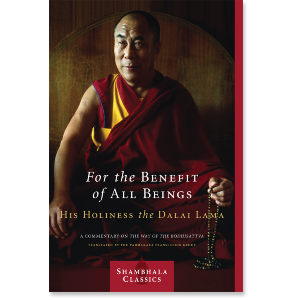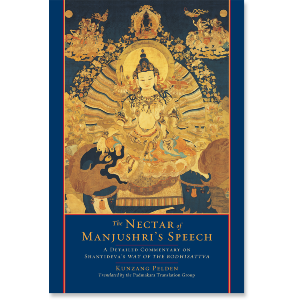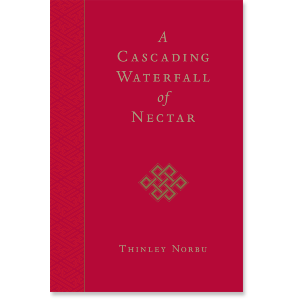| The following article is from the Winter, 1994 issue of the Snow Lion Newsletter and is for historical reference only. You can see this in context of the original newsletter here. |
A Teardropin Chenrezig's Eye
Article written by Victoria Huckenpahler
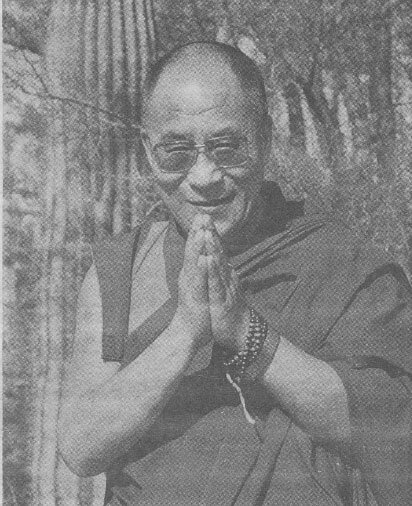
His Holiness The Dalai Lama XIV, Tucson, AR circa de 1994
H.H. The Dalai Lama Gives a Five-Day Intensive Teaching on
Shantideva's Guide to the Bodhisattva's Way of Life
Shantideva: The Patience Chapter
Against a vast panorama of blue sky punctuated by mountains not unlike those of his native Tibet, H.H. the Dalai Lama presented an intensive teaching on the Patience chapter of Shantideva's Guide to the Bodhisattva's Way of Life. Dr. Howard C. Cutler, a Phoenix psychiatrist, Lopon Claude d'Estree, the Buddhist chaplain at the Univ. of Arizona, and Ken Bacher formed Arizona Teachings, Inc. to sponsor His Holiness' visit.
Words alone cannot do justice to the impact of this commentary on patience by one who has himself passed its harshest tests.
Analysis of the Anatomy of Anger
His Holiness began his commentary on Shantideva's text with an analysis of the anatomy of anger how it arises from a sense of injury, giving the illusion of acting as a protector in one's revenge. But because the harmful action has been completed, revenge cannot alter the situation. Indeed, it only complicates matters by causing the loss of physical health and mental peace, by destroying the virtue one has accumulated over eons, and by acting as a stumbling block to the bodhisattva vow. Proposing antidotes to anger which can be implemented in real life situations or in the imagination, His Holiness suggested that since anger is a part of our mind we can engage in a dialogue with it.
anger arises from a sense of injury, giving the illusion of acting as a protector in one's revenge. But because the harmful action has been completed, revenge cannot alter the situation.
The Development of Tolerance
He also counseled the development of tolerance, ranging all the way from the ability to endure minor physical inconvenience, such as poor weather, up to the high level tolerance of the Bodhisattva. If we learn to ignore small sufferings, we become sturdier in the face of larger troubles. Because suffering is a fact of life, it is a useful reminder of the fundamentally unsatisfactory nature of existence, which helps us develop a taste for renouncing samsara. Endurance of suffering must, however, be understood within the context of the Buddha's Third Noble Truth: the end of suffering. One endures to reach a state beyond suffering, otherwise the emphasis on stamina would be merely morbid.
suffering is a fact of life, it is a useful reminder of the fundamentally unsatisfactory nature of existence, which helps us develop a taste for renouncing samsara.
Why feel compassion toward an aggressor?
His Holiness cautioned that the cultivation of steadfastness did not imply that all situations should be accepted. Some circumstances require counter-measures, but even here one's principal concern is the well-being of one's opponent rather than personal gain. If, by not remarking on someone's ill deed one tacitly helps that person develop a negative habit, such passivity would constitute an infraction of the Bodhisattva vow. One is therefore sometimes bound, out of compassion, to take a strong stand. But why feel compassion toward an aggressor? His Holiness explained that it is because such a person is in the causal state of accumulating non-virtue, whereas oneself as victim has already experienced the ripening of negative karma.
Some circumstances require counter-measures, but even here one's principal concern is the well-being of one's opponent rather than personal gain.
His Holiness remarked that a disciplined mind is a religious mind, and far more indicative of a spiritual life than outer displays such as robes or shrines. He then elaborated on Shantideva's statement that people inflict harm without the consciousness of real choice. Rather, they are moved by negative emotions dependent on a collection of conditions. These conditions, in turn, have no choice or intention to produce a result. Thus, nothing has independent status or control over itself. If we examine the situation carefully we see that in many cases people harm themselves out of ignorance or carelessness. If this is so, how more easily can they visit the same on others? Thus we should respond with compassion, not anger.
people inflict harm without the consciousness of real choice.
Are afflictive emotions caused by habit?
A question arose as to whether afflictive emotions were caused by habit. The Dalai Lama responded that afflictions result from a continuum of conditioning which, within Buddhism, must be understood in the framework of reincarnation. In a single family each member is born with natural tendencies which are later enhanced by conditioning. These tendencies can only be attributed to the beginninglessness of consciousness. Here he likened the practice of Dharma to a surge suppressor because it helps stabilize our moods.
afflictions result from a continuum of conditioning which, within Buddhism, must be understood in the framework of reincarnation
How are we personally responsible when we experience anger?
The discussion progressed to personal responsibility involved in situations where we feel anger. If we are injured, we must reflect that it is our own karma which has attracted our misfortune. Further, it is our attachment to the body that has led us to acquire a material form whose nature is to feel pain. And once we accept the inevitability of pain within samsara, how greatly we suffer depends on how we respond to situations.
His Holiness laughingly remarked that whereas we are often hypersensitive about minor issues, we ignore major points having long-term consequences. He recalled the Tibetan saying, treat insults like wind behind your ear i.e., pretend you haven't heard a slight and in this way you protect yourself. He reiterated the truth of dependent arising, and how collections of conditions, rather than clear cut personal volition, usually lie behind injury. Citing the example of the Gulf War, he said: many people blame Saddam Hussein. That is not fair. I feel some kind of sympathy for him. He is a dictator and there are bad things, but without that powerful equipment his army couldn't function. All that equipment wasn't produced by itself! Many nations were involved.
Noting the human tendency to blame situations on external factors, exonerating oneself, he related this to the Tibetan situation. If we look at things the holistic way we cannot pinpoint one person. Much contribution was made by ourselves and the previous generation. It's not fair to blame everything on China.
once we accept the inevitability of pain within samsara, how greatly we suffer depends on how we respond to situations.
How does one practice altruism?
Later, the discussion shifted from the elimination of anger to the active practice of altruism, whose basis is compassion. However, compassion is not to be confused with attachment, which can readily turn to hatred. Whereas attachment relates to subjective relationships with friends and family, genuine compassion is based on an objective awareness that others have as valid a wish as oneself to gain happiness and be free of suffering.
Describing attachment to sounds, tactile sensation, etc., he called sexual attachment the strongest of all because in it attachment to all five senses is completed. He then contrasted relationships based on immediate gratification in which individuals relate not as persons but as objects, with those in which there is underlying appreciation such that the individuals accord each other respect. There is some role of compassion here because there is a sense of responsibility.
Turning to the doctrine of karma and its role in bringing about negativity, he corrected the misinterpretation causing some people to blame karma alone for their woes. If we understand karma properly we know it means action, so that far from becoming passive we take initiative. Karma is not static, but a process, which indicates that the individual plays a large role in determining his or her course.
genuine compassion is based on an objective awareness that others have as valid a wish as oneself to gain happiness and be free of suffering.
Gurus and Staying True to the Dharma
His Holiness urged caution in choosing a spiritual guide. Referring to certain crazy wisdom gurus of the past, he noted that although such beings often manifested strange behavior, they had skills denoting a high level of spiritual realization. But some modern-day teachers have the same excesses, yet lack the counterbalancing factors! Once having chosen a guru, we should reject his actions if they go against Dharma. Students should make sure they don't spoil the guru! If unhealthy things happen you are at liberty to reject.
His Holiness then remarked that we tend to resent praise and other benefits received by our enemies. Yet praise is little more than empty sounds, and if we try to justify our craving for it on the basis of immediate gratification, we could as easily justify substance abuse. Further, praise is a distraction to practice because it undermines dissatisfaction with cyclic existence. Then, when you read about the faults of samsara, you begin to think, "maybe this was just written by some impoverished meditator living in a far-out place having nothing to do with the world!"
If one has the material comfort one needs for practice, there must also be an internal restraining factor so that one doesn't become self-indulgent. If you are aware of this, it is possible to see enemies who are obstacles to wealth as protectors who keep us from the obstruction of being spoiled.
His Holiness concluded by referring to the historic signing of a peace agreement between the Israelis and Palestinians, noting that he had personally written the leaders involved. One sensed in the minds of the audience the unspoken thought of His Holiness' own unresolved plight.
Why is praise a distraction to practice? ...because it undermines dissatisfaction with cyclic existence.
How is Merit Acquired?
His Holiness recalled Shantideva's statement that all virtues and favorable circumstances in our life are the results of merit acquired through our kindness to other beings. Moreover, health, possessions and friendship are inevitably dependent on others' effort and cooperation. Even those who harm us enable us to acquire merit, so that in terms of contributing to our welfare sentient beings play an even greater role than the Buddhas.
At this point His Holiness was for several long moments completely overcome by emotion. When at last His Holiness resumed speaking, he said: though sentient beings are fully equipped with faults and delusory states of mind, yet even with these limitations their contribution to our well-being shouldn't be underestimated. So we should be all the more grateful to them. The statements made by Shantideva are not exaggerations.
Noting the parallel between Buddhist compassion and Christian practice, His Holiness noted that if one mentally substituted God for the Buddhas, one could carry the practices, because to live in a way that pleases God is reflected in the way one deals with fellow beings. But to generate compassion it is necessary to appreciate the pervasiveness of suffering. Normally, only when we see someone in pain do we feel spontaneous sympathy; successful people rouse our envy. Ifwe reflect on the impurities of the body, we see that even successful people are within the bondage of suffering. So one should try to develop a sense of urgency like an AIDS patient. Once you have that illness you know your days are numbered. Think: as long as I am under the power of ignorance, sooner or later something negative will turn up, so I must work now.
Even those who harm us enable us to acquire merit, so that in terms of contributing to our welfare sentient beings play an even greater role than the Buddhas.
As he left the hall that day, His Holiness saluted the Buddha figure in the thangka above his chair with one hand as if to say hi. The familiar gesture conveyed an enchanting sense of intimacy, as of one being having long had vast experience of the other.
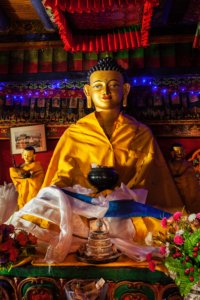
Mental development takes time.
Group discussion: Questions asked to the Dalai Lama.
Q: What is the Buddhist position on abortion?
A: We believe human life in general is precious, even though a lot of people are troublemakers! Normally, to control precious life is not advisable, but today there is too much precious life! So logically we have to think about birth control. Now abortion is killing. It should be avoided, but there are always exceptions for example if a child will be deformed and great suffering will result on the mother's or child's side. The Buddhist way of looking at things is to take situations on a case-by-case basis.
Q: What is the role of solitude in enlightenment?
A: Some of the monasteries are busy I think too much. These days people think that if there are no ritual performances like beating drums, the monastery is not complete. That is wrong. (Here he assumed a wrathful expression.) Monasteries must be filled with meditation. Without that it's just like any other institution.
Q: Is there a way to train our minds so we are not overwhelmed by suffering in the world?
A: In my own case, there is a big difference when I compare my mental attitude today with twenty or thirty years ago. I learned Buddhism since five years old, but at that time I had no interest in it even though I was its highest incarnation! Around sixteen years I began some serious feeling. Then in my twenties, in spite of many difficulties when I was visiting China, I made effort from within.
Around age 34, as a result of serious effort my understanding about shunya became real. But still Bodhicitta was very difficult. I admired that kind of mind as something marvelous, but in terms of practice I was still far. My mind was in very bad shape! But mainly as a result of Shantideva's book and Nagarjuna's Ratnamala [see Buddhism of Tibet section on Precious Garland] I got some kind of conviction. So look . . . more than 40 years!
Sometimes when I meet people who claim to have high realizations within a short period of time, it makes me laugh, though I try to hide it! Mental development takes time.
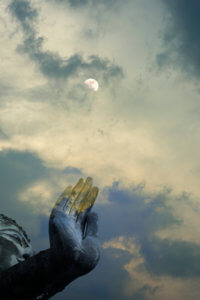
Conclusion
The Arizona teachings left a deep imprint on the hearts and minds of those fortunate enough to attend. Perhaps the episode which best sums up the Dalai Lama's power to capture the devotion of his followers occurred one afternoon. Exiting the conference room, he was assailed by the usual crowd, from which stepped a young Chinese woman, clearly distraught. Grabbing His Holiness' hand, she relayed how she had recently left Tibet where for five years she had been a guide for a Chinese tour group. I have seen your picture in Lhasa, and always I knew I would see you, she said. I took visitors to the Potala and I knew you couldn't be there. At this point she broke down completely.
Embracing the woman and pressing her head to his heart, His Holiness said,
"Like that we can solve any problem."
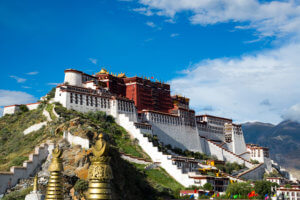
The Potala Palace symbolizes Tibetan Buddhism and its central role in the traditional administration of Tibet. It was the winter palace of the Dalai Lama from the 7th century until 1959. Since then, the Dalai Lama has since lived in exile in northern India, where the Central Tibetan Administration is also established.

